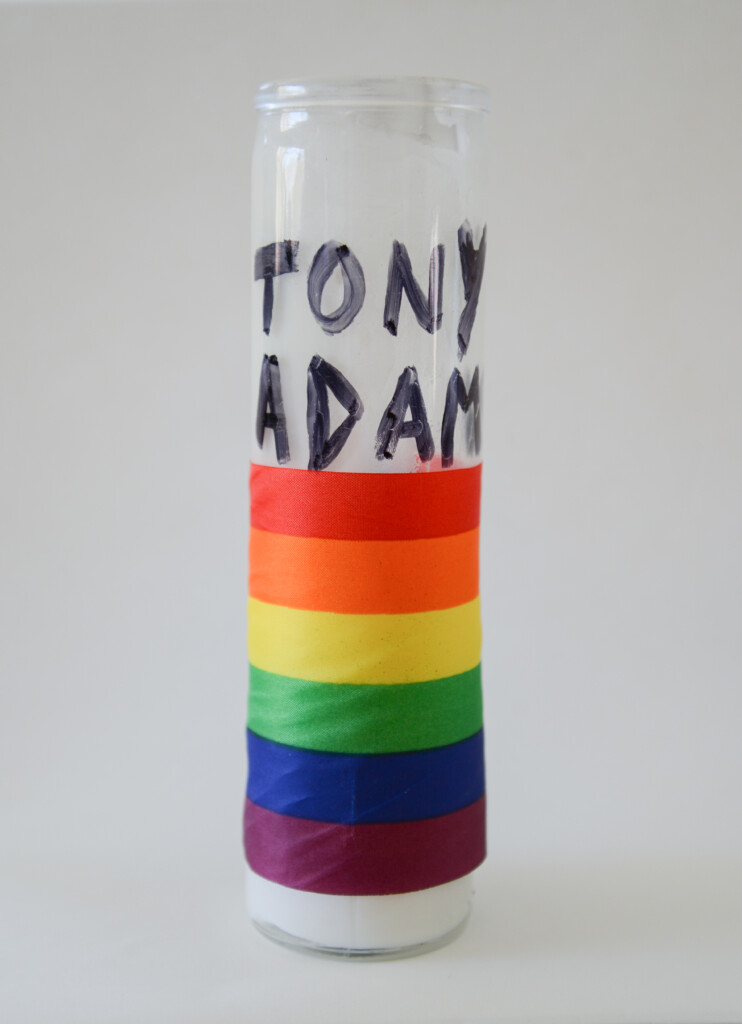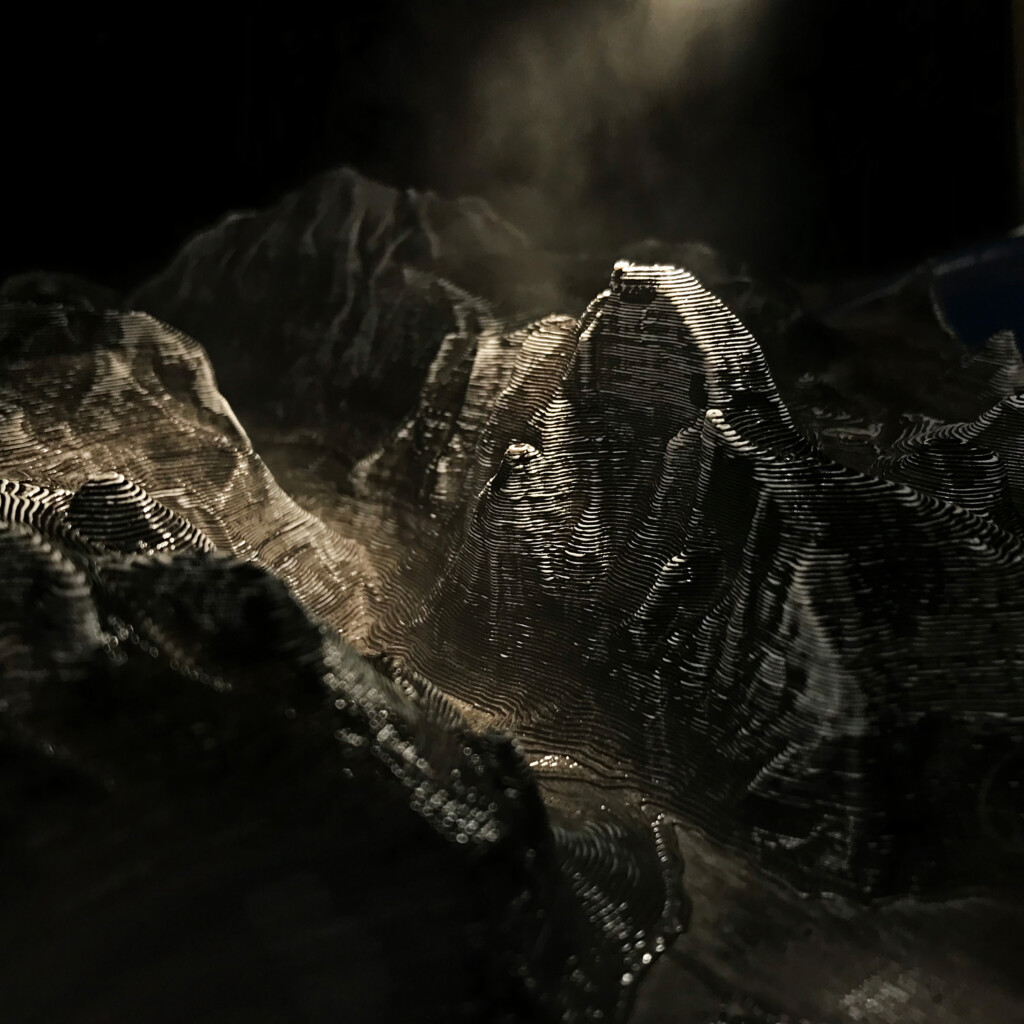For the last University of Utah faculty artists exhibition, held three years ago, the show’s title was Site Lines, which played on a phrase familiar to architecture – the function of the sightline which preserves a specific line of sight for an important or meaningful space when a new building is designed. The artists, working figuratively and metaphorically, approached this thematic concept in ways that not only divided but overlapped sites and spaces – nature and human-made structures, text and imagery, abstract and representation, the creative discipline of art and other disciplines including science, biology, chemistry, political history and other areas.
Now, 18 months after the COVID-19 pandemic transformed so many routines of our lives, Space Maker, the newest show of works by University of Utah faculty artists, expands our thinking about space, spaciousness, and the presence of personal boundaries and public distancing as they have evolved during a turbulent period where not only the pandemic has dominated but also the largest display of social protests, acute tensions in contemporary politics and the inevitable acknowledgment of climate change and its human-related impacts have magnified the tenor of this theme. The show at the Utah Museum of Fine Arts (UMFA) represents works by more than 30 faculty artists, including for the first time, pieces created by adjunct faculty members in the university’s Department of Art and Art History.

The exhibition’s layout of the dozens of work likewise emphasizes the spaciousness of the artists’ aesthetic considerations. The show invigorates the senses and minds of its viewers who readily will capture and be captivated by the same type of emotional awareness that inspired creating a particular work of art in the first place. Guest curator for the show is Nancy Rivera, a Mexican-American visual artist, curator and arts administrator based in Salt Lake City. Rivera is visual arts coordinator for the Utah Division of Arts & Museums.
The spaciousness of the American West is prominent in several pieces. Edward Bateman presents pigment prints on rag paper from the Seeking Sublime series, featuring Yosemite National Park and Mount Watkins. Viewers will take note of the accompanying 3-D model, which the artist photographed to create the prints. The model, which incorporates the essential geographical details and data and was produced with a 3-D printer, is a fascinating bit. Thus, the printed images Bateman ends up with show the plastic filament strands as convincing depictions of the unique features of Yosemite. By acknowledging how travel plummeted particularly during the early phases of the pandemic, Bateman’s work is a masterful bit of creative genius, all being accomplished at home. The prints are so effective that they evoke a comparison to the same quality of print that was captured by a photographer of the late 19th century who would have been at Yosemite. These prints are as stunning as those Bateman presented at the 2018 faculty show, Reversing Photosynthesis, which were produced by placing decaying leaves in direct contact with light sensitive photographic paper and left in darkness for an extended period to document the change.

A similar effect to be appreciated comes in the astute accommodation of negative space and ink marks on the pigment prints of Lewis J. Crawford (Construct No. 3-5 (Bell & Tree) and Construct No. 3-7 (The Summary of an Adventure). Meanwhile, the series of six white charcoal on paper drawings by Al Denyer convey the juxtaposition of timelessness and precariousness of preserving the images of Stansbury Island (A Sense of Place Chasing Stansbury I-VI).
Among the newest adjunct faculty members featured is Kylie Millward, who also completed her degree in 2020. Millward’s work reflects the healthy encouragement to be versatile and cross over freely from one medium to another. This includes The Rhythm of Menstruation, featuring digital animation, and the screenprint Domestic Remiss, a work that is richly textured with thematic layers that connect to each other. The work depicts the wide range of household chores that historically have been relegated to women and Millward portrays the figure trying to lighten (and even neglect some of) the workload in curious, whimsical and even slapdash ways. Millyard makes evident how the pandemic’s impact especially burdened women who either left their jobs or were forced to work from home. The workload at home became more complicated and less convenient to handle, thereby emphasizing how circumstances still have changed so little for women who are expected to juggle the roles of jobs and housekeeping.

Brian Snapp, whose work in recent years has responded to the conditions for refugees and migrants where hope and fear are simultaneously present, offers 13 3-D ceramic objects as part of his House of My Brother / House of My Sister series. He mixes yeast into the making of his clay sculptures, an example of how failed materials become the gateway for potent artistic expression on such themes. In this instance, one can read into the pieces the alarming awareness of how once stable, iconic figures are being ripped apart in a time of violent polarization in American communities and the difficulties of reconciling to the realization that there could be sufficient space to accommodate everyone. Snapp also had work shown in last spring’s Material Issues: Strategies in 21st Century Craft exhibition at the Utah Museum of Contemporary Art.
Beth Krensky’s video installation piece, Dispatch from Solitude #1: Walking the Unknown Path: Emigration Canyon, Utah, was filmed on May 19, 2020 and expresses one’s attempts to recover from aimlessness and the tenuous circumstances of pandemic-related experiences and the motivation to survive and escape from the pandemic’s worst effects. This format is one Krensky has finessed well, as shown in the last faculty art show three years ago, when she presented an installation that also included a video piece. In the earlier work, Float Away, she paid tribute to her deceased mother in a production filmed near the Great Salt Lake and featured kites made from remnants of her mother’s clothing. For the latest work, she chose Emigration Canyon – a deeply symbolic location for the Indigenous people of the Ute Tribe as well as for Mormon pioneers who entered the Salt Lake valley in 1847. The artist is seen in the familiar PPE garb worn by pandemic healthcare workers, including the mask and Tyvek suit. She has a chair strapped to her back with the words of the aptly chosen 23rd Psalm scrawled on its seat. Commissioned by Ogden Contemporary Arts, the piece includes the efforts of photographer Cam McLeod and videographer Dylan Totaro.

Haynes Goodsell presents a found object, a candle from a memorial created to honor Anthony Adams, a gay African-American student at The University of Utah who was murdered in 1978. The case has never been solved. The memorial, which included candles, Pride flags and flowers, cropped up on the 40th anniversary of the murder at the building where Adams lived and where Goodsell now resides. As Goodsell explains in an accompanying artistic statement, “This event was a tragedy, but it also marks the great changes the queer community has gone through. I am also gay and living within these same walls. My situation, though improved—due to the advocacy work of many over the years, in addition to my own white privilege—still poses great challenges for any individual who identifies as queer these many years later.”
There are so many inventive gems in Space Maker. Marnie Powers-Torrey, who heads the Book Arts program at the university’s J. Willard Marriott Library, presents Roadside Attraction, 2018–2021, a masterly done letterpress artist book. Each of the volumes she has produced for Roadside Attractions is a one-page book with a snakefold construction and on each smaller page there is a finely rendered image of a found and/or discarded object. It’s up to the viewer to create their own map of the object pages to represent their own journey from this miniature caravan of a publication.

The exhibition also is presented in gallery sections that coalesce around thematic strands or medium aesthetics in unique, unconventional ways. In one section, there are several impressive examples of the dramatic changes in the natural environment, along with the problems and risks arising from human dominion and climate change. Paul Stout’s All watched over by machines of love and grace is a mixed media piece presented as an automatic flip-it station message board. Periodically and regularly, the board’s letters flip with clacking sounds, ultimately ending upon the Latin binomial nomenclature representing any one of various animal species that have gone extinct. Carol Sogard presents a stunning trio of wallpaper prints with repeated patterns, each signifying a category of an endangered ecological community (sea, land and sky). Wendy Wischer’s mixed media form Reflecting Hope, a tree of wire, mirrored mylar and light, evokes a glimmer of optimism that humans collectively can muster the will toward stemming the inevitable decline and deterioration of the planet’s natural environments and of existing species. Indeed, this particular sculptural installation is the appropriate companion to the larger, more complex piece she presented in the 2018 faculty show, which was inspired by lines of verse in William Blake’s Auguries of Innocence.
Space Maker is on view through Sunday, Dec. 5. It’s one of two UMFA exhibitions this fall that celebrate work by Utah-based artists. 2020: From here on out, a project that invites community artists to paint original murals in the Museum’s Great Hall, is set to open Saturday, Sept. 25.

Exhibition-related activities include a free virtual activity on photography as part of the museum’s Third Saturday for Families Online series (Sept. 18), which will be available at the UMFA website. A virtual performance by members of the university’s dance school faculty will be presented Oct. 7 at 7 p.m. A live performance by members of the university’s music faculty will be presented Nov. 17 at 6:30 p.m. in the UMFA’s G. W. Anderson Family Great Hall.
Space Maker is supported by Installation Sponsor UMFA Art Lovers and presented in partnership with the U’s College of Fine Arts and Department of Art and Art History, with in-kind support from the Utah Division of Arts and Museums.
See the UMFA website for current hours of operation, admission, directions and ticket information. Advance tickets are strongly encouraged.

